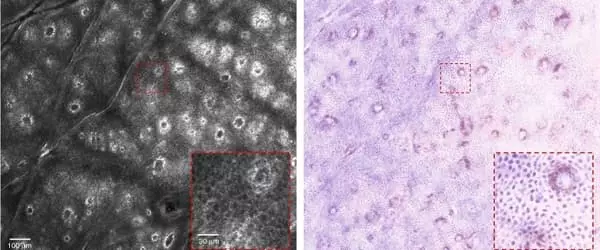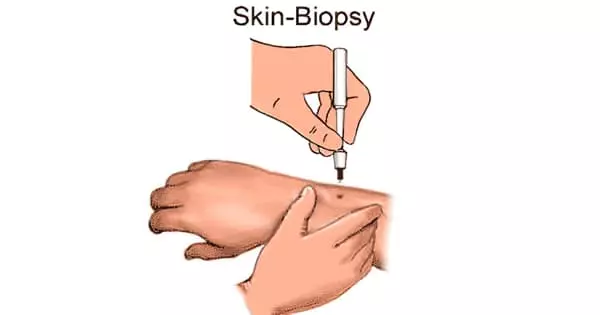A new ‘virtual histology’ technology shows promise by analyzing images of suspicious-looking lesions and quickly producing a detailed, microscopic image of the skin, skipping several standard diagnostic steps such as skin biopsy, tissue fixation, processing, sectioning, and histochemical staining.
Rather than surgically removing a sample of skin, sending it to a lab, and waiting several days for results, your dermatologist photographs a suspicious-looking lesion and quickly produces a detailed, microscopic image of the skin.
According to today’s article in Light: Science & Applications, a journal of the Springer Nature Group, this could become routine in clinics as a result of a new “virtual histology” technology being developed by researchers at UCLA’s Samueli School of Engineering and David Geffen School of Medicine. Histology is the study of tissue structure at the microscopic level.
“This method avoids several standard diagnostic steps, such as skin biopsy, tissue fixation, processing, sectioning, and histochemical staining. Images resemble biopsied, histochemically stained skin sections viewed through a microscope slide “Aydogan Ozcan, Chancellor’s Professor and Volgenau Chair for Engineering Innovation in UCLA Samueli’s Electrical and Computer Engineering Department, was the study’s senior author.
This framework is capable of performing virtual histology on a wide range of skin conditions, including basal cell carcinoma. It also offers detailed 3D images of various skin layers.
Aydogan Ozcan
The technology, which has been in development for more than three years, may open up a new path for the rapid diagnosis of malignant skin tumors, reducing the number of unnecessary invasive skin biopsies and allowing for earlier detection of skin cancer. Previously, this technology was only used on microscopy slides containing unstained tissue obtained through a biopsy. This is the first study to use virtual histology on intact, unbiopsied tissue.
“The current gold standard for diagnosing skin diseases, including skin cancer, is invasive biopsy and histopathological evaluation. This frequently results in unnecessary biopsies and scars, as well as multiple doctor visits. It can also be costly for patients and the healthcare system “Dr. Philip Scumpia is an assistant professor of dermatology and dermatopathology at UCLA’s David Geffen School of Medicine and the West Los Angeles Veterans Affairs Hospital, as well as a member of the UCLA Jonsson Comprehensive Cancer Center. “Our approach has the potential to provide a biopsy-free solution by providing images of skin structure with cellular-level resolution.”

The research team, led by Ozcan, Scumpia, and Dr. Gennady Rubinstein of the Dermatology & Laser Centre in Los Angeles, developed a deep-learning framework to transform images of intact skin acquired by an emerging noninvasive optical technology, reflectance confocal microscopy (RCM), into a format that dermatologists and pathologists can understand. RCM images require special training to analyze because they are black and white and, unlike standard histology, lack nuclear features of cells.
“I was surprised to see how easily this virtual staining technology transforms the images into those I typically see of skin biopsies processed using traditional chemical fixation and tissue staining under a microscope,” Scumpia said.
The researchers trained a “convolutional neural network” to quickly convert RCM images of unstained skin into virtually stained 3D images similar to the H&E (hematoxylin and eosin) images familiar to dermatologists and dermatopathologists. Deep learning, a subset of machine learning, builds artificial neural networks that, like the human brain, can “learn” from massive amounts of data.
“This framework is capable of performing virtual histology on a wide range of skin conditions, including basal cell carcinoma. It also offers detailed 3D images of various skin layers” Ozcan, who also teaches bioengineering and surgery at UCLA and is an associate director of the California NanoSystems Institute, agreed. “In our studies, the virtually stained images exhibited color contrast and spatial features similar to those found in traditionally stained microscopic images of biopsied tissue. This method may enable clinicians to see the overall histological features of intact skin without invasive skin biopsies or the time-consuming work of chemical processing and labeling tissue.”
This is an exciting proof-of-concept study, according to Rubinstein. “Dermatoscopes, which magnify skin and polarize light, are currently the only tools used in clinics to assist dermatologists. At best, they can assist a dermatologist in detecting patterns “Rubinstein, who also uses reflectance confocal microscopes in the clinic, agreed.
Several steps remain in translating this technology for clinical use, according to the authors, but their ultimate goal is to provide virtual histology technology that can be built into any device, large or small, or combined with other optical-imaging systems. Once the neural network has been “trained” with a large number of tissue samples and the use of powerful graphics processing units (GPUs), it will be able to run on a computer or network, allowing for the rapid transformation of a standard image to a virtual histology image.
Future research will look into whether this digital, biopsy-free approach can be used in conjunction with whole-body imaging and electronic medical records to usher in a new era of “digital dermatology” and change the way dermatology is practiced. In addition, the research team will see if this artificial intelligence platform can be used in conjunction with other AI technologies to look for patterns and aid in clinical diagnosis.





